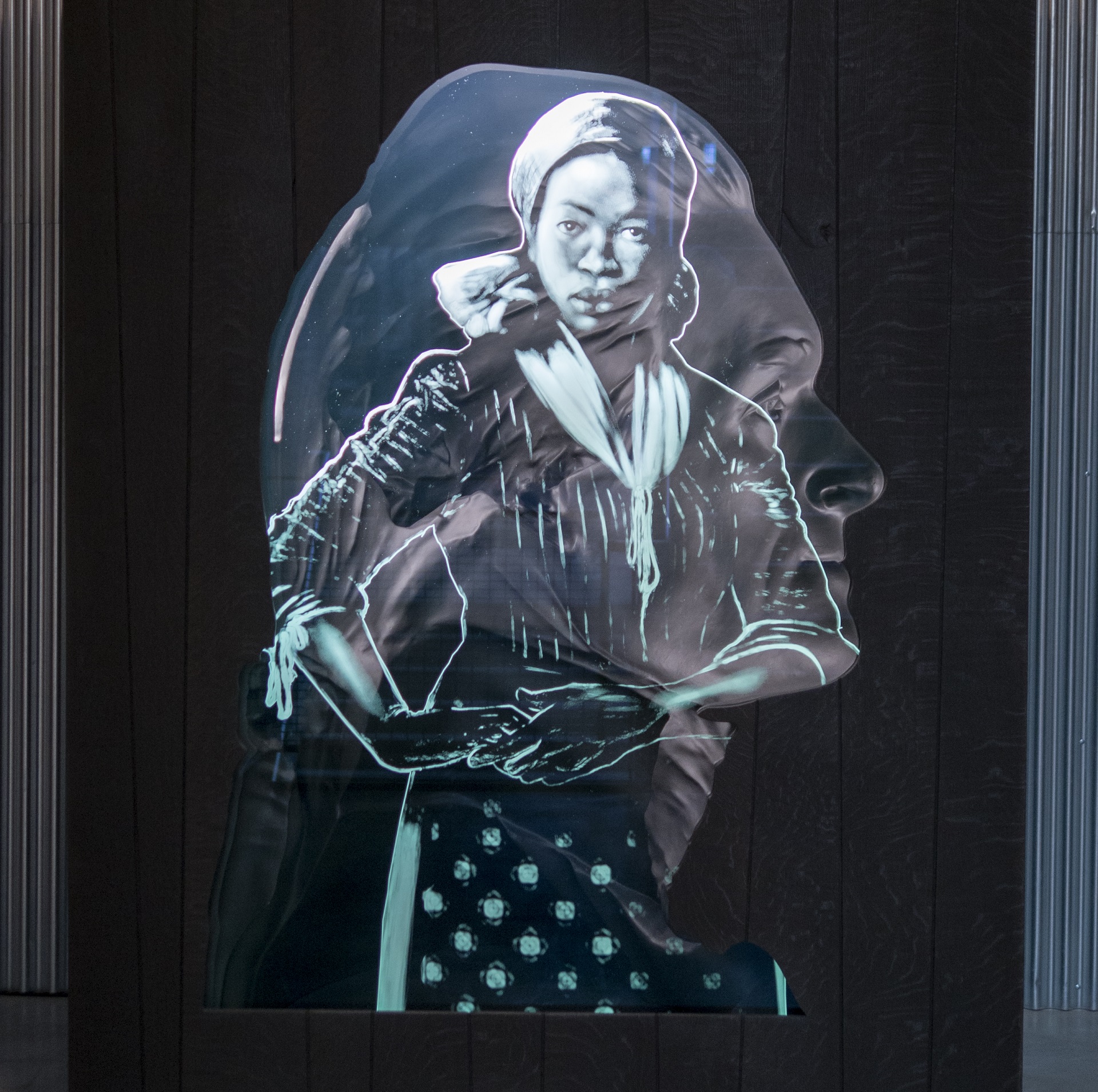
Archive Exhibitions, Exhibition
- August 31, 2018 - March 30, 2020
- B6: The Robert W. Wilson Building
The artist Titus Kaphar is first and foremost interested in history – and in particular whose stories get told, and which ones get left out. Through cutting, bending, sculpting, and remixing historic paintings and sculptures, Kaphar often shifts the focus of the narratives to create new works that exist between fiction and quotation.
In 2017, Kaphar was commissioned by Princeton University to create a new sculpture, Impressions of Liberty, which discusses the University’s own history of enslaved people. On July 31, 1766, six enslaved African Americans were sold on the site where the sculpture now sits. They were part of the estate of Samuel Finley (1715–1766), the fifth president of Princeton (then the College of New Jersey). Kaphar’s work begins as a monumental bust of Finley carved as an inversion into wood. Framed against this are portraits of an African-American man, woman, and child “etched” into glass. The Princeton website states that, “Whereas the form for Finley’s bust is drawn from his official University portraits, contemporary actors in eighteenth-century costume stand in for the enslaved individuals, for whom no images remain.”
Using this same technique, Kaphar has created Language of the Forgotten. Just as in Impressions of Liberty, he starts with a Caucasian historical figure — here Thomas Jefferson. His profile is immediately recognizable, whereas the figures “etched” on the glass stand in for the hundreds of thousands of untold narratives about usurped liberty — most famously brought to light in Jefferson’s case through the story of Sally Hemings, an enslaved woman on Jefferson’s plantation believed to be the mother of his children. In both works, Kaphar delicately alters the narrative, placing forgotten figures who are in plain line of sight.
This sculpture relates to additional works by Kaphar that will be on view in the group exhibition Suffering from Realness, opening April 2019.
For Language of the Forgotten, Kaphar commissioned poet Reginald Dwayne Betts to write the new poem below:
Benevolence
by Reginald Dwayne Betts
A woman disappears behind the face
of a man. Negro child, girl child, Black child,
what is the language for forgotten? Hidden
behind a veil of declared independence.
Not a single signature would have confessed
her name in public. The lesson of owning
begins with erasure. Who confuses a woman
for property. (Many men, many many many many men.)
Not someone else. Mister & Master. Not mistress —
but eclipse. Blacker
than cotton falling into the shade of a sack longer
than her frail body. How do you say child
in the language of a whip post?
Behind him, the sound of a woman effaced.
The office of expunction:
man & ownership & the collateral of it all, a body
sprawled against its own vanquishing.
Always half the tale. What wasn’t lost
in the chronicle? Hosannas. All men created
with a backdrop of a woman forced
into an awkward submission? Lascivious becomes
something mutual. Negro girl slave girl slave girl
as lover black girl as lover black woman as lover
permission as lost continent.
The conundrum is unmasked by a knife
against the canvas. Behind the man
a woman shackled to what the ghost rib?
Only men believe in women as asterisk.
Imagine being remembered this way. Imagine resurrection
as being unmasked,
imagine benevolence as being seen.
About the artist
Titus Kaphar’s works interact with art history by appropriating its styles and mediums. He cuts, bends, sculpts, and mixes historic painting, creating new works between fiction and historic sampling. His work has been included in exhibitions at Jack Shainman Gallery, New York, NY; the Studio Museum in Harlem, NY; and the Seattle Art Museum, WA. His art is also in the collections of the Museum of Modern Art, New York, NY. In 2014, Time magazine commissioned Kaphar to create an artwork in response to the protests in Ferguson, MO. He lives and works in New Haven, CT.
Further Reading
At MASS MoCA, artist Titus Kaphar leads us back from the abyss, The Boston Globe
TITUS KAPHAR
Language of the Forgotten, 2018
Charred white oak, high-density urethane, glass and LED lights
Courtesy of the artist

